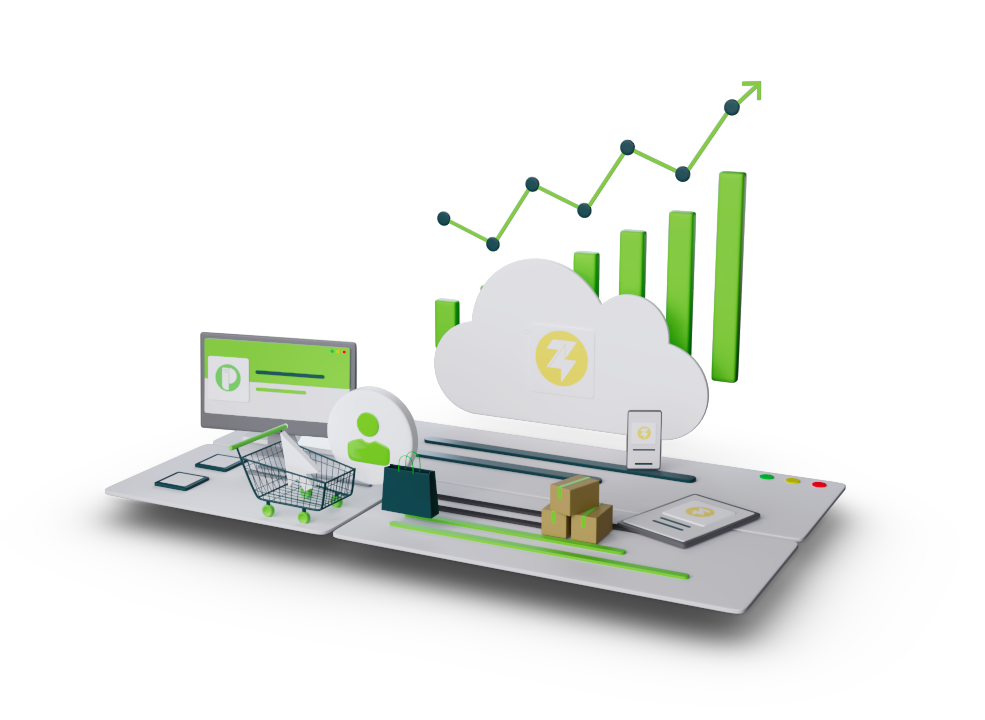The Value of Generating a Real-time P&L for Your Business
Recent trends show that many retailers and wholesalers in India are grappling with cash flow gaps and margin erosions because their financial reporting lags behind operations. When the monthly or quarterly Profit & Loss (P&L) report finally lands, it often confirms problems that should have triggered corrective action weeks ago.
P&L statements are the backbone of financial literacy for any business. They tell you whether you’re profitable or bleeding cash, whether costs are spiraling, or if sales are growing but margins are shrinking. P&L statements are indispensable for strategic planning, satisfying investors or creditors, and performance measurement.
However, traditional P&L reporting functions in a way that most of the damage is already done - missed warning signals, unanticipated cash shortages, inefficiencies that go uncorrected, all because the data is stale. As businesses face fast market changes, competitive pressure, rising input costs, and regulatory demands, the ability to generate a real-time P&L becomes a competitive necessity.
Why Old-Style Reporting Fails and Real-Time Delivers
In many businesses, financial reporting follows traditional cycles: monthly closes, quarter-ends, and fiscal year ends. Data flows in from stores, warehouses, procurement, etc., is consolidated, journal entries are adjusted, then the P&L is published. This process can take days or even weeks after the period ends.
During that period:
- Revenue trends may have shifted for good or bad but aren’t visible.
- Cost overruns (e.g. in labour, logistics, spoilage) may accumulate unchecked.
- Inventory problems, stockouts or overstock, remain hidden until reconciled.
- Pricing forces such as discounts, promotions, or vendor rebates can erode margins before finance teams can detect the impact.
In contrast, a real-time P&L means that sales, costs, inventory changes, and overheads are being fed continuously into your financial system, offering benefits such as:
- Accuracy: With more frequent data input, there are fewer estimates and guesswork.
- Responsiveness: If sales drop in a product line or if there’s a pricing mismatch or costs surge, you see it quickly.
- Reduced error: Manual batching and reconciliation introduce mistakes. Real-time systems automate much of this.
Because you’re working with up-to-date figures, you can make timely adjustments to pricing or promotions mid-campaign if margins begin to slip. Inventory can be shifted between stores or warehouses to prevent dead stock buildup. Discounting and markdowns can be managed proactively instead of reactively, protecting both sales and profitability.

Ensure audit readiness and GST compliance effortlessly with Ginesys’ automated reconciliation tools.
Sharper Forecasts and Smarter Cash Flow
Forecasting Accuracy
Forecasting sales, costs, or cash needs is only as reliable as the data behind it. With real-time P&L, forecasts update continually as new sales, expense, inventory, supplier, and market inputs arrive. Variances appear earlier, giving time to adjust strategies before issues escalate. It also helps to factor in seasonal trends, promotions, or external shocks like shipping delays and cost inflation more promptly, resulting in sharper, more realistic projections.
Cash Flow Management
Cash flows are sacrosanct, especially in retail, distribution, wholesale. A real-time P&L helps you to:
- Identify upcoming cash gaps: Payables coming due, receivables lagging, inventory tied up.
- Optimize receivables: Follow-up on slow paying customers when you see receivables aging in real time.
- Manage payables: Negotiate with suppliers if you see cash pressure and decide which bills to prioritize.
- Ensure liquidity: Know your true cash position so you can plan for emergencies, investments, or growth moves without jeopardy.
Avoiding Surprises
Without real-time visibility, surprises can come in the form of unexpected cost spikes (fuel, power, labour), inventory shrinkage or damage, and missed sales targets or over-discounting. These can turn into crises. With real-time P&L, these are flagged early enough to mitigate.
Tightening Costs While Protecting Margins
Proactive Cost Control
Real-time P&L makes cost control proactive by letting businesses spot inefficiencies like high transport costs, overheads, or vendor charges as they occur. It also highlights leaks from unclear vendor contracts, or unused resources, high logistics pricing, while tracking labour, utilities, and maintenance costs with daily or weekly visibility.
Product Lines / SKUs / Stores Analysis
Not all products or stores perform equally, and some drag down margins. Real-time P&L helps identify SKUs with high returns, low sell-through, or high COGS, as well as underperforming stores where costs are excessive or sales volume is low. This visibility enables resource reallocation, promotions, inventory, and staff, to more profitable products or locations.
Dynamic Budgeting
Static yearly budgets often fail to reflect actual conditions, but real-time P&L enables rolling forecasts and dynamic budgets that adjust continuously. Businesses can reassign allocations mid-period, such as marketing or promotions, and set realistic targets without being trapped by outdated projections.

Gain instant financial clarity with Ginesys ERP and POS integration for seamless real-time P&L reporting.
Boosting Credibility with Stakeholders Every Day
Investors, Lenders, Partners
Stakeholders, whether investors, lenders, or partners, look for confidence which comes from transparency and timely financial data. A real-time P&L signals that management is in control and actively monitoring the business. During due diligence, audits, or evaluations, showing that financials are accurate, up to date, and readily available makes a major difference. Banks and creditors are more likely to trust your creditworthiness when they see profitability and cash flow tracked on a daily or weekly basis.
Audit Readiness & Regulation
Errors or omissions in financial books can be costly, especially under GST and e-invoicing regulations. With real-time P&L, audit trails are timestamped, reconciled, and easily accessible, making audits smoother and more reliable. Regulatory reporting becomes less risky as compliance is integrated into day-to-day operations rather than treated as a last-minute task.
Internal Leadership Confidence
Inside the organization, real-time P&L boosts confidence at every level, whether it’s the board, the C-suite, or store-level managers. Leaders no longer need to wait for monthly or quarterly report cards to make decisions; they can act with conviction based on live financial insights. This agility eliminates second-guessing and ensures strategies are aligned with current realities, creating stronger, more decisive leadership.
Unified Decisions: How Finance, Sales, and Ops Teams Win
Finance Team
For finance teams, a real-time P&L reduces bottlenecks significantly by cutting down on manual consolidation and minimizing late surprises. With less time spent reconciling data, teams can shift their focus to higher-value tasks such as scenario planning, in-depth analysis, and advising operations or sales.
The result is cleaner books with fewer errors, stronger compliance, and smoother audits, allowing finance to play a more strategic role in the business.
Operations Teams
Operations benefit from immediate financial feedback. If inventory shows problems like spoilage, shrinkage, or stockouts, supply chain and store teams can pivot quickly. Real-time visibility also enables a faster response to cost pressures such as rising freight or labor expenses, helping operations find efficiencies before margins take a hit.
With clearer insights into performance, resources like staff, inventory, and physical space can be reallocated more effectively, boosting both productivity and profitability.
Sales & Marketing Teams
For sales and marketing, live P&L data turns into actionable insight. Promotions can be adjusted or ended if they start eroding margins, ensuring campaigns remain profitable. Teams can fine-tune the product mix to emphasize high-margin SKUs or categories while reducing focus on underperformers.
Real-time insights also strengthen channel strategy, clarifying which sales avenues, whether online, marketplace, or physical stores, drive profit versus just top-line revenue.
Cross-Team Collaboration
Perhaps the greatest advantage of real-time P&L lies in collaboration. With everyone working from the same live data, silos are broken down and contradictory numbers are eliminated. Shared dashboards and KPIs align goals across departments, reduce friction, and encourage coordinated action. This unified approach helps the business move faster, with all teams pulling in the same direction.

Multiple Outlets, One Financial Pulse
For businesses with many stores and outlets, franchises, or warehouses, the complexity multiplies but so do the benefits of real-time P&L.
Seeing Which Stores Lead and Which Lag
Real-time P&L by location lets businesses continuously compare performance across outlets. Underperforming stores can be flagged early, whether due to rent, staffing, or local competition, so that corrective action is swift. At the same time, top-performing outlets can be studied for success factors like promotions, staffing, or merchandising and replicated elsewhere.
Centralised Oversight & Resource Redistribution
Centralized visibility enables management to shift inventory, capital, or promotional support in real time where it matters most. Best practices can be rolled out quickly, while shared procurement and resource pooling deliver cost savings and reduce location-wise variances.
Consistency in Reporting & Consolidation
Real-time P&L ensures consistency when consolidating data across outlets or regions. Clean reporting minimizes surprises like missing expenses, unrecorded transfers, or inconsistent costs, making the financial picture clearer and more reliable for faster decisions.
Regulation, Audit and Compliance in India Made Easier
GST, E-Invoices, E-Way Bills
With real-time P&L data, sales and purchase transactions can be classified accurately by state and GSTIN. Integrated ERP and POS systems that handle compliance tasks like e-invoicing and e-way bills ensure output tax and input tax credit (ITC) are posted correctly, reducing the risk of penalties or rejections for late or incorrect filings.
Audit Trail & Error Flagging
Every invoice, cost, and stock movement is traceable, with anomalies flagged instantly. This makes reconciliation of inter-branch transfers, returns, and vendor invoices smoother and helps businesses maintain accuracy and accountability in their financial records.
Digital Tax Compliance
The Indian government is increasingly pushing for digital tax compliance, with more frequent and real-time reporting requirements alongside stricter enforcement. Without real-time financial visibility, businesses risk being caught off guard and facing compliance challenges.
What Holds Businesses Back and How to Move Forward
Key Obstacles
- Legacy systems: Many older POS or accounting systems are not designed for real-time integration, limiting visibility and slowing down decision-making.
- Fragmented data sources: When different stores, sales channels, and warehouses use separate tools, consolidating data becomes complex and error prone.
- Resistance to change: Teams that are comfortable relying on monthly reports may resist the shift to real-time reporting, as it requires greater discipline and adaptation.
- Implementation cost: The upfront investment in technology, change management, and retraining can deter businesses from moving toward real-time P&L.
- Data quality issues: Inconsistent product codes, misclassified costs, and dirty data undermine reporting accuracy and can make insights unreliable.
Strategies to Overcome Them
- Phased rollout: Begin with select stores or product lines to test and refine the approach, then expand gradually across the business.
- Strong integration between systems: Ensure ERP, POS, finance, and inventory systems are fully integrated so that data flows seamlessly without the need for manual intervention.
- Training and change management: Build internal champions and provide training so employees understand the purpose of real-time P&L, how to interpret dashboards, and how to act on insights.
- Ensuring data hygiene: Maintain consistent product masters, cost definitions, and a standardized chart of accounts to improve accuracy and reduce reporting errors.
- Leadership buy-in: Secure active support from management to drive adoption and foster a culture of accountability around real-time financial visibility.
- Set realistic expectations: Clarify that real-time doesn’t necessarily mean instant updates to the second but rather define what near real-time or acceptable latency means for your business.

Consolidate multi-location P&L performance instantly with Ginesys’ cloud-ready retail management platform.
Technology as Enabler and ERP/POS Role in Real-Time Visibility
How POS & ERP Systems Feed Financials
- POS systems capture the point-of-sale transactions: revenue, discounts, returns, promotions, payment mode. If integrated with the financial system immediately, these feed into the P&L.
- ERP systems capture procurement, supplier invoices, inventory valuation, overheads, payroll, warehousing, return handling, inter-branch transfers.
Key Features to Look For
- Live dashboards / visualization of P&L, cost, margin by product / store / channel.
- Real-time inventory costing: cost of goods sold (COGS) needs correct, up-to-date inventory valuation.
- Auto-reconciliations: bank, sales, purchase, discounts, vendor returns, etc.
- Seamless integrations: POS → ERP → Accounting → Compliance modules.
Role of Modern Architecture
- Cloud enables data availability across locations; supports modest upfront infrastructure; easier to scale.
- APIs make real-time or near-real-time data transfer possible between systems: POS, inventory, accounting, compliance.
- Data architecture i.e. enterprise data warehouses or data lakehouses, well-structured dashboards, ability to drill into exceptions.
Why Ginesys is the Smart Choice for Real-Time P&L Management
Ginesys is a leading cloud-native retail ERP + POS platform built to bring real-time financial visibility, seamless compliance, and growth-ready scalability to multi-channel businesses. What sets Ginesys apart is how its unified system links every sales, inventory, cost, and financial module so that data flows continuously, minimizing reconciliation lag, reducing errors, and giving decision makers live insights.
Unified ERP + POS Platform
Ginesys combines desktop POS, Web POS, and mobile POS app/Zwing POS in a single ecosystem. Integrated with the ERP module, transactions such as sales, returns, discounts, and stock movements sync instantly to the central ledger, while inventory and cost data update in real time. This eliminates silos and outdated manual uploads.
Multi-Location and Consolidated Visibility
For businesses with multiple stores, warehouses, or franchises, Ginesys delivers branch-wise P&L and automatic consolidation. Store-level transactions post directly to corporate books and can be viewed by outlet, region, or channel. Live syncing of stock, sales, and costs gives HQ full visibility, while month-end closes shorten because reconciliation happens continuously.
Automation, Compliance, & GST Features
Through its EaseMyGST module, Ginesys automates GST reconciliation, e-invoicing, e-way bills, and return filing (GSTR-1, GSTR-3B, Annual Returns). The system flags mismatches, automates workflows, and ensures correct posting of output tax and input credits, reducing risks of penalties or late filings.
Real-Time Insights, BI & Forecast Tools
With live dashboards, unified pricing engines, and analytics, Ginesys helps teams track margins, inventory health, promotions, and demand forecasts continuously. POS and ERP sync in real time so stock movements and sales are visible to head office as soon as they occur.
Scalability and Flexibility
Ginesys is modular, cloud-ready, and built for omnichannel retail. Whether adding outlets, launching a webstore, or integrating marketplaces, businesses can adopt modules incrementally. Starting with POS + Inventory, they can expand to compliance, BI, or OMS, scaling smoothly with transaction volumes.

Transform your business agility with Ginesys ERP + POS integration designed for omnichannel retailers.
From enabling faster decisions, tighter cost control, improved forecasting accuracy, to boosting stakeholder credibility and fostering cross-team alignment, the benefits of a real-time P&L are broad, measurable, and often transformative.
If your current systems deliver P&Ls only after the fact, or in partial batches, it’s time to evaluate whether you can move toward a real-time P&L capability. Platforms like Ginesys offer the ERP, POS, BI and compliance framework to make that transition smoother. The shift may require investment and change management, but the returns in decision agility, margin protection, operational efficiency, and stakeholder trust, can far outweigh the cost.

